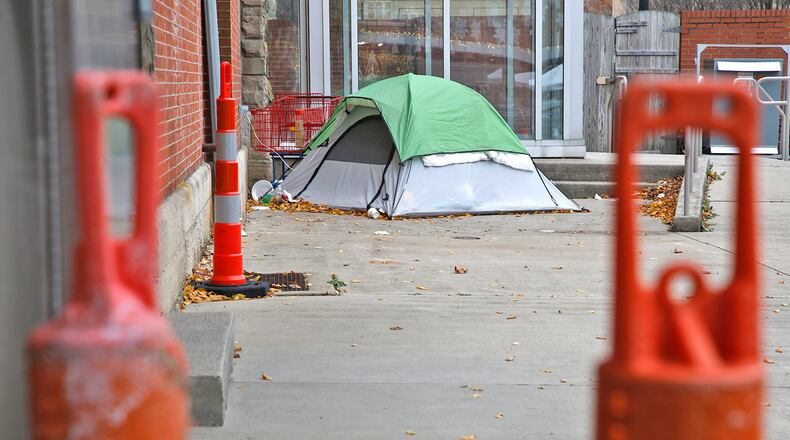The coordinated entry process, which designates an access point in the community, is meant to ensure that everyone experiencing homelessness who seeks helps has a place to stay and a way out of the system, if possible.
“This plan is the beginning — it is not the end of working to eliminate homelessness in Clark County, and while there’s a lot we don’t have ... there’s really no excuse for not taking concrete actions right now to make a better Clark County,” Tina Koumoutsos, housing coordinator at the Clark County Combined Health district and leader of the task force, told Springfield city commissioners last week.
How many people are experiencing homelessness in Clark County?
According to the task force report, the number of people using emergency shelters in Clark County increased “drastically” following the COVID-19 pandemic. In 2019, there were 608 individuals reported as using emergency shelters. This increased to 613 in 2020, 1,067 in 2021 and 1,474 in 2022. As of Oct. 16 of this year, 460 people have been served in shelters, according to the report.
Numbers of people considered as experiencing chronic homelessness — people who are disabled, live in areas not meant for human habitation, have been homeless for at least a year or experience recurring homelessness — have increased, too. The number went from 85 in 2019 to 87 in 2020, and 115 in 2021 to 119 in 2021. As of Oct. 16, 81 people have been identified as chronically homeless.
Koumoutsos said that up until earlier this year, only Sheltered Inc. provided shelter to people experiencing homelessness.
The homelessness task force was formed due to a “crisis of homelessness” during the COVID-19 pandemic, with organizations including housing providers, service providers, government agencies, nonprofits and faith-based organizations, according to the report.
From 2018-2022, there have been some positive trends, with most individuals who leave emergency shelters staying or living with family or friends. Most destinations were permanent.
Credit: Bill Lackey
Credit: Bill Lackey
2023 homelessness challenges
2023 has proven to be a difficult year for providing adequate services to people experiencing homelessness.
The city dealt with the aftermath of the November 2022 demolition of the West Main Street encampment, called “Tent City” by its residents. These people were relocated to city hotels and motels.
What started off in 2020 as a small cluster of two or three tents grew as the nation reported more people experiencing homelessness. The encampment grew to nearly 30 residents at its peak, with others coming to sleep near the encampment in their cars and vans, Springfield Soup Kitchen operator Fred Stegner said last year.
In February the county terminated a portion of a $700,000 contract — of which about $495,000 was reimbursed — with local homelessness nonprofit Sheltered Inc. after “multiple violations” in regards to the reimbursement of funds were found following a review. The shelter lost other funding sources and shut down one of its temporary shelters for about three months until OIC began funding it on a per-head basis, allowing it to reopen the shelter.
Springfield purchased the Villager Inn last December to serve as a longer term solution to homelessness, but a fire in August resulted in it being declared a public nuisance and demolished. No future plans for a long-term homelessness campus have been made public.
The city also purchased the Executive Inn in January to serve as a temporary homeless shelter for about a year while the city intended to bring the Villager Inn online. A portion of the Homefull-operated Executive Inn shelter opened in late July, with families being accepted as each room was brought online.
But in August, a pipe burst, damaging the former hotel, and six families had to be relocated. After repairs, Homefull was housing 25 families as of Nov. 16. It is expected to have 75 units once work is complete.
Recommendations for 2024
The task force in September said they would work to revamp the coordinated entry process, which they said suffered from inefficiencies and communications issues. The report identified steps to increase the entry capacity, including funding for a full-time position to manage the entry process, adding an access point in addition to Sheltered Inc. and hiring a consultant to help standardize the pathway to permanent housing.
Increasing the number of affordable rentals and homes for purchase was also identified as a goal for next year. The task force plans to create a map of sites that could house multi-unit housing projects, increase staff capacity by taking part in low-income tax credit and bond financing training, identify developers for these projects, allocate grant funds for at least one affordable housing project and get written documentation of neighborhood support for these projects.
The task force believes a permanent emergency shelter campus that has supportive services on site would be beneficial, according to the report. To achieve this it will seek a consultant to evaluate the former Villager Inn site or another site to determine whether or not it is a suitable location and seek partnerships.
The group has a similar goal of a permanent supportive housing campus. Finding funding for special populations like ex-offenders is also a priority here.
Specific data would help service providers predict and more easily meet the needs of the community, according to the report. This includes eviction data and a more standardized system of data collection across agencies.
One of the most important goals is to identify and create a budget request for more funds in order to pay for planning, the study of the coordinated entry process, collecting data and more, according to the report.
Koumoutsos said that federal and state funds are limited and local funding will help fill some gaps.
“We do have a long way to go and we do need to start our work,” Koumoutsos said.
About the Author


